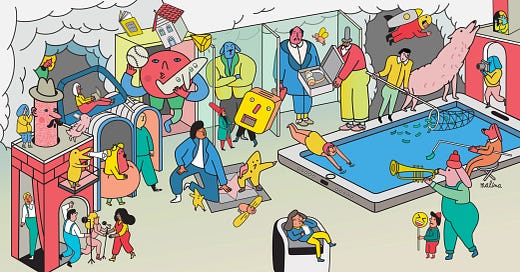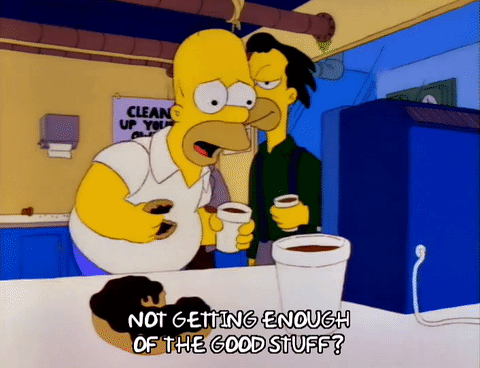👋 What Clubhouse has taught Founders?
Though the FOMO is gone but here are the key takeaways for your startup from Clubhouse.
Hey everyone👋, welcome to the 10th newsletter.
I had a thing going on in my mind for a long time now that if I had to take away a few things from Clubhouse’s curve then what it would be & how I can try them on my startup.
I love building products & I’m currently building one, so it’s natural I’ll consider what I can take from Clubhouse after a year of beta launch. Though my observation isn't around the future of it rather what made the app get the hype & then suddenly slow down (and what you should too).
And, why not?
Its founders are successful and they did create a feature that every other platform want to have. Look at Twitter, they are publicly working on creating a look-a-like of Clubhouse called Twitter Space.
But it's not just Twitter - Facebook, LinkedIn, Discord, Spotify and Slack all are working on it.
So, how it becomes the next big thing? Here are my thoughts 👇🏻
🔥 Keep things simple
The one thing I like about Clubhouse is how simple it has kept its branding - even after a year-long beta launch, very simple design, emoji logo, no landing page or fancy website or not much social media presence.
All they focused on was building the product.
We tend to go for perfectionism before even getting a single user - name, font, landing page, blog, social media, etc. and consider the product as the second. Instead we need to work on getting the product out as soon as possible. Get users, build a community & then work on architecture.
Takeaway 🙌🏻
✅ Start with what you have.
✅ Don't go for perfectionism.
✅ First focus on building product & users, then the rest of the things.
🏗 Build community & connections
Build connections & community over time - that’s what the founders of Clubhouse did. Which became the plus point of its success, coming through having a community prior.
The Clubhouse founders were able to take leverage of their connections with VC & startup founders which helped them get the buzz.
You can build connections & community in any form: writing newsletters (like I’m building), articles, being active & making meaningful connections on Twitter, etc. If you have 10 people who would be happy to support your work - you’re building your connections & community. It’s doesn’t need to be only the top tier people.
Here's a piece I wrote on building community first, then a product.
💡 Marketing, but not marketing
Seriously, have you seen any ads or promotions for Clubhouse?
No, because they did the basic things. This is how they got more than 10 Million users.
Niche down to the target user & only gave access to them first. - They niche down by targeting founders & VC first, which helped them build a great community.
Their target users helped them spread word of mouth. - The quickest way to spread like fire.
They ship features fast which helped them stay in the eye. - You need to ship features fast and you can easily take advantage of being in the early stage, especially when you’re the only one (or few more people) working on building the product. You can ship 2-3 features on a regular basis, get feedback, make changes immediately & continue this process.
Call out to influencers. - Clubhouse founders took advantage of their connections. You would listen to people you admire & look up to and it’s easy to attract their users. Hence, get their audience.
🙅🏻♀️ The hype was a disadvantage!
The hype & growth Clubhouse experienced I believe was a big disadvantage. This is not what they were ready for (you can see they don’t know what to do & how to keep up with the competitors & build users).
See through this scenario 👇🏻
You got an idea & work on a few features to test on the beta list. They are enjoying it. Then you get the popular celebrities & the world’s greatest thinkers onboard - such as Elon musk (in sense), Kevin Hart, Tiffany Haddish, Oprah, etc. Now, you’ve got thousands of downloads overnight.
But you actually don’t know what to do with the app; how to make it better, how to keep up with the user retention, how to get creators, etc.
You created the FOMO by making everyone feel exclusive - an easy way to have a one-on-one unscripted conversation with popular people & listen to them.
When you were still testing (on iOS & only accepting new users on an invite basis), you build up competitors. You really have no idea how to keep up with the unexpected growth, hype & then suddenly user’s not using your app.
🤷🏻♀️
Takeaway 🙌🏻
✅ Have a vision of how you’ll grow your product.
✅ Extensive hype doesn’t always result in product success.
✅ Know how to keep your users engaged with your app.
✅ If you get a huge success, know how to keep a hold on it.

🤺 Competitors
Well, this is a topic I would love to discuss in-depth in my upcoming newsletter but for now, let’s talk about Clubhouse competitors. (*Update you can read here)
If you’ve built something that everyone’s using, you’re also building competitors.
“All failed companies are the same: they failed to escape competition.” ― Peter Thiel
You cannot run away from competitors but you can still be better than them. You just need to figure out how to make difference from your clones.
Since the mid-2020, Clubhouse has been the talking point of the tech market. There were talks that Twitter was buying it but then Twitter quickly started publicly working on the same feature.
Which was a bad thing for Clubhouse because Twitter was also testing on Andriod & CH was only available on iOS.
But look how things turn around for Snapchat. Sometimes the idea doesn't matter but the execution does. Also, it's not who came up with the idea first, but who kept growing with it.
🛠 Retention & User engagement
The biggest downfall of Clubhouse is its content & not very engaging users. They find it difficult to keep up with the user retention rates, and the most popular people aren't able to help them too.
Bad chat rooms are causing more damage to the platform than good rooms providing value.
They are trying to improve retention, but somehow it’s not working for them. With features like scheduling, Q&A tools, and monetization content, they still lack curation.
As a founder, one of your most important tasks is to retain & keep your users engaged with your product. This is where Clubhouse didn't focus. They build up the hype, got millions of users but couldn't keep them on their app.
Takeaway 🙌🏻
✅ Monitor the content
✅ Keep your users engaged with your product
✅ Look for what users want
Check out this poll 👆🏻
💭 Finally,
If the app is seeing less growth than the previous months doesn't mean it's the end. Though the FOMO somehow seems to be gone, Clubhouse isn’t over yet.
Let me know if I’ve missed some points👇🏻 in the comments below.
Until next time! 👋
👋 PS: I’m Ritika founder, product marketer and advisor for early-stage startups, find more here or connect with her here. If you’re a first-time founder looking for curated resources, download here. If you enjoyed this post, read the past issues here. You can also promote your product in this newsletter.
A big thanks for reading & sharing!







